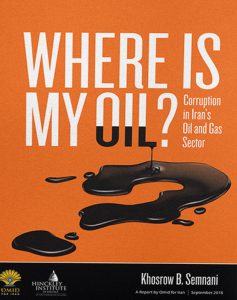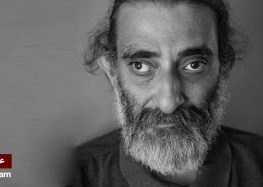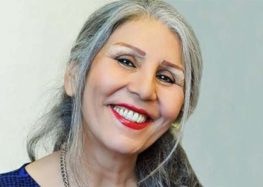Khosrow Semnani: Iran Funds Repression “Through Corruption by Design”

The Iranian-American engineer, businessman, and philanthropist Khosrow Semnani made a name in foreign policy circles in both Washington and Tehran in 2013 after he published a comprehensive report about the environmental and human costs of a military strike on Iranian nuclear facilities. Five years later he has published a new report, this time focusing on the socioeconomic effects of corruption in Iran’s oil industry.
In “Where is My Oil?”–the title playing off the chants of “Where is My Vote?” during mass street protests against the contested result of Iran’s 2009 presidential election–Semnani, based in Salt Lake City, Utah, argues that state forces repress the Iranian people through a system of “corruption by design” funded by oil revenues that belong to the people, not the government. With revenues from that oil accounting for 50%–60% of the country’s fiscal budget, corruption in the sector threatens the budgets of every ministry and deprives all sectors of Iranian society from the most basic services, according to the report. “If the corruption went away, the system would not be able to survive,” Semnani told the Center for Human Rights in Iran (CHRI) on March 26, 2019. Excerpts of the interview follow.
CHRI: How are you connected to Iran and how did you end up here in the United States?
Semnani: I was born in Iran and went to school in Iran and England. I have an undergraduate degree in physical sciences. In 1988, I established the first privately owned nuclear waste disposal facility in the United States. I operated that until 2004 when I sold it. Since then I have been involved in investments and other businesses, real estate…
The connection to Iran goes back to 1973 when I was last there; I have not been there since of course. After the revolution, unfortunately, the war started in 1980 and it was a disaster for Iran. Hundreds of thousands of young people were killed and there were billions of dollars of damage.
Since ‘84, I’ve been actively helping individuals and causes of human rights. Also, I served eight years as a member of the board of trustees of Encyclopedia Iranica, served three years as chair, and helped anti-war promotion of democracy in Iran, not directly, but indirectly. And of course, that takes us to the 2004-2005 discussions of Iran’s nuclear program and that became more and more prominent.
Later, in 2009, there were discussions of potential military attacks on Iran’s nuclear facilities and these discussions were mainly political and economic; nobody talked about the human dimension. So because of my background in nuclear sciences and knowledge of the consequences of the effects of an attack on the nuclear facilities as well as the impact to humans and the environment, I began to look at this issue and realized it could be very devastating for the Iranian people, mainly in Isfahan and Bushehr.
I undertook a study in consultation with Dr. Gary Sandquist, also a nuclear physicist, and the Hinckley Institute at the University of Utah in Salt Lake City to create this report, “The Ayatollah’s Nuclear Gamble,” regarding nuclear consequences and casualties of such an attack. We published it in 2012 and it was well received. As time went on, we saw that people inside Iran were realizing the consequences. Actually, the people of Isfahan, including the governor, were commenting on that themselves. The information actually got to Iran and people were reacting. The State Department and the Department of Energy also expressed interest and asked for copies. People were interested in the findings.
CHRI: It’s interesting that you brought up the issue of military conflict, because even today, we get this question a lot: Why should people talk about human rights in Iran when the whole country faces threats from the outside?
Semnani: One would not be honest with himself or herself if they didn’t connect the dots. In politics and economy, you have to connect the dots before you see the big picture. If you look at what’s going on in Iran, and even the current discussion of war, you have to ask yourself why Iranian people have found themselves in such a predicament.
 Iran’s 1979 revolution was created and based on a crisis. It was rooted in crisis and it has to live with manufactured crises. That’s the interesting thing. It’s all connected. In our latest report, “Where is My Oil?” we show that the question of human rights, corruption—all those things create a certain outcome. If you didn’t have the money through corruption, you wouldn’t have the forces or ability to sustain a non-popular regime in Iran that violates, on a daily basis, human rights. So they need that fuel, that money, to survive and that comes through corruption. We called this “corruption by design.” It was decided and implemented and has remained with the exact same methodology over the years to deliver a certain outcome.
Iran’s 1979 revolution was created and based on a crisis. It was rooted in crisis and it has to live with manufactured crises. That’s the interesting thing. It’s all connected. In our latest report, “Where is My Oil?” we show that the question of human rights, corruption—all those things create a certain outcome. If you didn’t have the money through corruption, you wouldn’t have the forces or ability to sustain a non-popular regime in Iran that violates, on a daily basis, human rights. So they need that fuel, that money, to survive and that comes through corruption. We called this “corruption by design.” It was decided and implemented and has remained with the exact same methodology over the years to deliver a certain outcome.
Some of the events that are happening today are symptoms of what the regime is designed to do. And the symptoms—human rights are one thing, corruption is another—these things are needed for the system to survive. If the violation of human rights goes away, the system cannot survive. If the corruption went away, the system would not be able to survive.
Our research demonstrates how these things are taking place. In the report, you can see how the dollars from oil revenues are used to essentially prevent Iranians from being able to ask for their human rights by the threats of intimidation and brute force.
CHRI: You also argue that Iran’s government should be a trustee of the country’s vast oil resources and that Iranians should reclaim what is rightfully theirs. Now let me play the devil’s advocate: Iran has very low taxes and the country is also plagued by tax evasion. Is it fair to say that the government should only be a trustee when it’s paying for the production and export of the oil?
Semnani: We have been raised to believe that the oil belongs to the government. But the government is just the trustee to manage the oil for the benefit of the people. You have to have accountability. Where is the oil going? Who is it being sold to? For how much? That’s the whole idea of national ownership. You need accountability. But Iranians have not claimed their ownership, and we’re talking about billions. Billions of missing dollars.
When the oil is shipped out and sold, the money doesn’t go to institutions or projects that help the Iranian people. Over the past 110 years, Iranian people have not claimed ownership of their oil. It is not the government’s oil; it is their oil. They should know that every time the income of a drop of oil goes to any place other than them, it is coming out of their pockets, their children’s pockets, and their neighbors’ pockets. It is their oil.
In 1978, Iran’s oil production was 6 million barrels a day. Today they say it is 1.5-2 million barrels a day. And we’re talking about billions of missing dollars. In our report, we look at the Ahmadinejad presidency, roughly 800 billion dollars of oil was sold. Where did it go?
Just in the period of 2005-2013, $304 billion went missing. Now, every dollar from oil that goes to the economy creates $3.6 for the economy (this is based on economic principles and that number is based on the Parliament’s own estimate). Because when you spend your dollar, you buy, you pay rent, your rent goes to the construction of something else, you buy food, it goes to the farmer and so on. But in a corrupt system by design that was implemented from day one, it delivers outcomes the government wants.
And you talk about human rights. Human rights are not given. They’re earned. They’re taken. I’m sorry to say something that may not be pleasant. You have to earn your human rights. Every right you have, you have to take; it’s not given to you. That’s the reality of human nature. Even today here in the United States, if you don’t ask for your rights, you don’t get them. Everywhere you go, it’s the same thing.
This plastic [Mr. Semnani picks up a water bottle] it’s 100% manufactured with oil. This plastic, it’s all made from oil, our oil. The car you drive, the metal, iron, copper, lead, anywhere between 33%-75% of it is energy, which is oil or gas. The initial cost of producing it all is energy. Over 30% of the cost of concrete is energy. It’s either oil or gas. In 2016, China used more concrete than the US and Europe combined. And guess who is the major supplier of energy to China? Iran.
The poverty line in Iran today is below 5 million tomans now. And the majority of teachers make 2.5-3 million tomans. They’re struggling. It’s not fair, not right. With this study we came up with, we showed that with 1 billion dollars, you could create 167,000 jobs in Iran. That’s huge. People should think about this. It’s not an abstract issue.
It offends me when Iran doesn’t have facilities for addicts to get treatment. It offends me that a woman stands on a corner to sell her body because she can’t find a job. As a person, as an Iranian, Muslim, Christian, Jew, whatever, anybody with any sense of morality should be offended. And this is the people’s money that has been stolen. So I think someone has to be answerable. And the way they become answerable is when people claim what is theirs.






